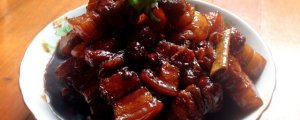
Taro in anti sand
(70880 views)
This is the amount that two people eat in the evening. If there are more people, please increase the amount by yourself.
Cooking ingredients
Cooking Steps

Step1:Cut taro into strips. As thick as the thumb. Don't cut it too thin. If it's too thin, it will be very greasy after hanging the sugar. ——I cut too thin this time. At first I was afraid it would not be cooked well. But it turned out that I would rather fry for a while than cut too thin.

Step2:Put oil in the pot. The oil just covers all taros. Heat the oil to six. Fry the taro. Don't turn it over with a shovel. It will break the taro. Fry for a while and shake the pan to avoid sticking. Fry for about four minutes, turn inside out, and then fry for another three minutes. When you decide to use a shovel to touch the taro surface, it's OK. You can start the pot. Don't turn off the fire when you start the pot. The taro will bring less oil when it comes out of the pot.

Step3:Stir fried sugar. Pour out the oil. Wash the pan. Here's the first technique to prevent anti sand from changing and drawing. There's no oil in the pot. Put in 4-5 ceramic spoons of sugar, and then put in 2 / 3 of the sugar amount of water. Open fire and burn the sugar with a small fire. Keep stirring.

Step4:Continue to stir fry after saccharification. Add 2 drops of vinegar when the sugar bubbles. ——This is taught by a friend. I don't know why. The second technique to prevent the sand from turning into silk. When the big bubble turns into small bubble, the sugar is stir fried. Do not stir until it is syrup like. The picture above shows the big bubble. The small bubble is more dense.

Step5:Next taro. The third skill to prevent the sand from changing and the silk drawing. Put the taro back-end pot out of the fire. Wrap the sugar evenly in the state of off fire.

Step6:If you follow the above method, you will find that the taro just after it is put into the pot is still in the shape of pulling silk. Don't worry. The fourth skill to keep the anti sand and the pulling silk is to wrap the taro evenly with syrup. Let it stand still. When the pot cools down, you will find that the syrup turns into icing. Anti sand success. But at this time, taro sticks in the pot. Then continue to heat on a low heat. Turn the sugar slightly. Shake the taro well. Leave the pot hot. Otherwise, it will stick to the bottom of the pot.

Step7:The last pot is like this. I think in order not to waste sugar, we should boil sugar water to drink.

Step8:The taro is made successfully. Be sure to eat while it's hot. It's like eating sugar when it's cold. It's too greasy.

Step9:The raw materials are sugar. The key is the temperature of sugar. Stir fried sugar with low temperature is needed for desalting. Stir fried sugar with high temperature is needed for drawing silk. The above techniques are also based on temperature. Here are a few more tips. 1. Stir fry sugar with water and anti sand. Stir fry sugar with oil when pulling silk. 2. Anti sand in sugar wate
Cooking tips:1. When melting sugar, there should be no oil in the pot. If there is oil, it's easy to draw silk. Turn the sand into sugar with water. 2. If taro is not immediately desanded after syrup is put on, turn off the heat and let the pot cool to desander. 3. When leaving the pot, it can be reheated to ensure that taro does not stick to the pot. If the taro sticks together after leaving the pot, it can be separated by hand. There are skills in making delicious dishes.
 Chinese Food
Chinese Food












